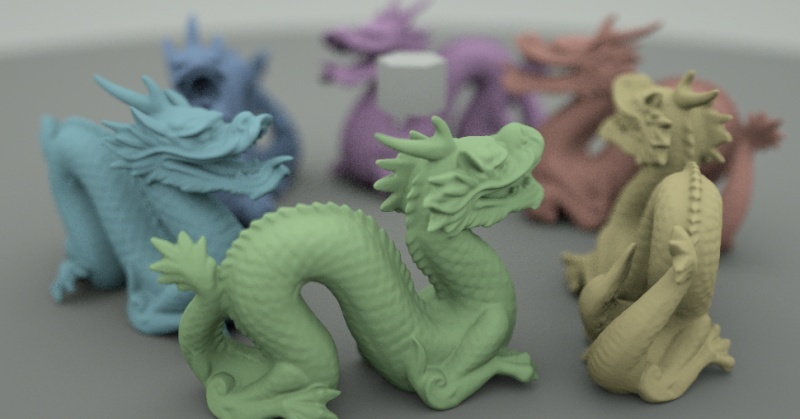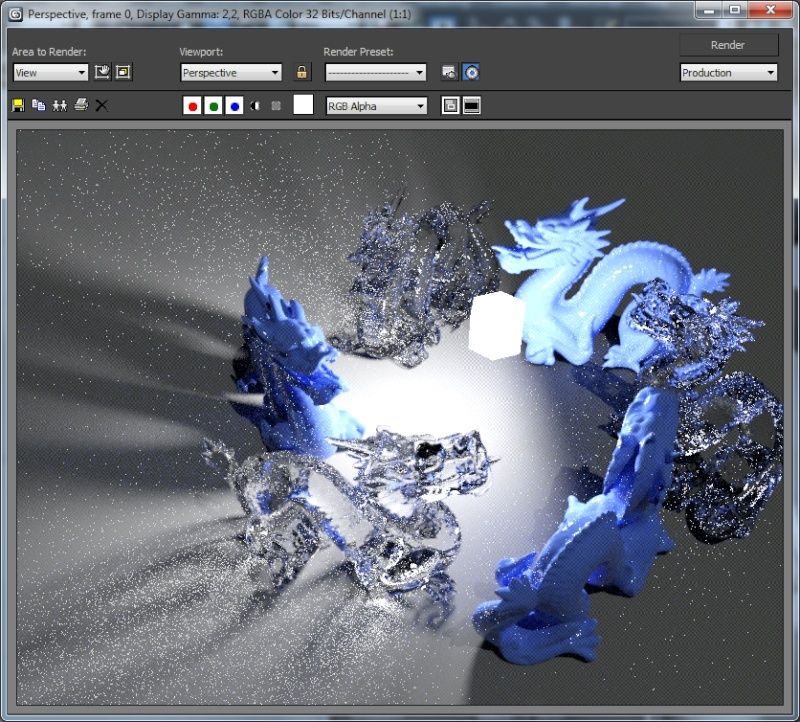Tracing the path to the GPU, part 2
The first part is found here .
Well, consider:
Video card: Nvidia GeForce GTX580 (it’s necessary to take into account that not everyone wants to buy a top-end video card for the not yet developed GPU rendering technology), Frequency shaders 800 MHz, 512 CUDA cores.
Test scene: the dance of Standford's high poly whelps dancing around a glowing hexagonal prism hanging in the air.

Here are these guys.
')
What we want to achieve: minimum noise at minimum computational cost.
Difficulties:
1. Most tested renders do not support SSS .
2. The Octane Render and Arion Render demo versions are limited in resolution, and “ball on the surface in daylight” scenes are cleared of noise quickly even on CPU renderers, especially with such a small resolution.
3. The complexity for all types of rendering is the rendering of indirect lighting, in particular the interiors, and especially the caustic , on which we dwell.
Octane Render
OctaneRender_DEMO_1024_beta246b_win_x64
Pleased with the speed in direct light. The picture at 1000x600 resolution is almost completely cleared. in 3-5 seconds.

Now let's do caustics.

And where? What about Physically Based?And why did I take such a vidyahu?
I waited for as long as 15 seconds until at least something enlightened, not enlightened even after a few minutes. Twisted all the settings. So it is either not there, or it is cut in the demo version (then how can you cut such important things in the demo version?).
I resent.
Minuses:
1. Caustic does not work!
2. There is no SSS (campaign, only in the demo version)
3. Inconvenient editor of materials, primitive shaders.
I really want to see the editor of materials as in Maxwell or Fry, where each material consists of several layers, in my opinion is very convenient.
Iray
In the box with 3ds Max 2012.
Unlike Octane, iRay renders caustics:

iRay on the 15th second, may there be a caustic!
Minuses:
1. There is no interactive visualization (the picture cannot be rotated in real time), however, when using 2 video cards, iRay renders interactively (I don’t know how to count the geforce, but when using the quadro +, the tesla works exactly).
2. Few primitive shaders like Octane.
Arion
RandomControl ARION (64-bit) - v2011.08.19 - v1.5.02 Beta DEMO
Arion is a very peculiar program. By the interface, he reminded me Maxwell (he and Fry reminds), is quite convenient, a good editor of materials.
However, there are different bugs, for example, there is a function to rotate an object, but the point about which it rotates an object is somewhere very far beyond the screen, so instead of looking at an object from different sides, we often “fly away” in an unknown direction. I noticed that I was being treated by creating a new camera, which immediately knows about which point to rotate.
Another interesting bug has affected all the test scenes. It turns out that if you remove the light of the sky - the light sources will not shine. Why? Can light sources work on solar batteries located somewhere nearby? I noticed that this is not treated in any way, except as “we will make a gray sky in all renders”, for the sake of fairness of tests.
In addition, Arion quietly renders on the CPU. The truth is very calm (in my case, the core i5 2500 was inferior in rendering speed 4-5 times).

Minuses:
1. Autofocus does not work.
2. SSS is present, but not working.
3. A lot of caustic noise.
4. Many bugs and flaws.
Cycles
Found in a box with Blender 2.60
Surprisingly, a VERY good opensource (built into a special Blender assembly) render.
Supports OpenCL, CUDA, can also render on the CPU. There is an opportunity to contemplate the result directly in the Blender viewport. You can move (!) The geometry there (though it will be hard if the geometry is complex).
I would like to:
1. Embed it in 3D Max, Blueprint, Reno and other packages.
2. Add SSS.
3. Add nat. sky.
4. Enable optimization of ERPT or MLT in order to reduce the time to reduce the noise from the caustics.
5. Add photo-tonemapping for natural color reproduction.

Minuses:
1. Who does not love / does not know the blender - will not be able to use it.
2. Primitive shaders.
3. There is no physically correct procedural sky.
Indigo, Lux renders were not tested, because not 100% GPU renderers. Using video cards, they speed up the computational process, but their speed is significantly lower than true GPU renders.
GPU unbiased renders have not yet come to the masses, they have many flaws, but their fate is predetermined. Computing technology on graphics accelerators significantly increases rendering speed.
Draw conclusions, gentlemen!
Well, consider:
Video card: Nvidia GeForce GTX580 (it’s necessary to take into account that not everyone wants to buy a top-end video card for the not yet developed GPU rendering technology), Frequency shaders 800 MHz, 512 CUDA cores.
Test scene: the dance of Standford's high poly whelps dancing around a glowing hexagonal prism hanging in the air.

Here are these guys.
')
What we want to achieve: minimum noise at minimum computational cost.
Difficulties:
1. Most tested renders do not support SSS .
2. The Octane Render and Arion Render demo versions are limited in resolution, and “ball on the surface in daylight” scenes are cleared of noise quickly even on CPU renderers, especially with such a small resolution.
3. The complexity for all types of rendering is the rendering of indirect lighting, in particular the interiors, and especially the caustic , on which we dwell.
Octane Render
OctaneRender_DEMO_1024_beta246b_win_x64
Pleased with the speed in direct light. The picture at 1000x600 resolution is almost completely cleared. in 3-5 seconds.

Now let's do caustics.

And where? What about Physically Based?
I waited for as long as 15 seconds until at least something enlightened, not enlightened even after a few minutes. Twisted all the settings. So it is either not there, or it is cut in the demo version (then how can you cut such important things in the demo version?).
I resent.
Minuses:
1. Caustic does not work!
2. There is no SSS (campaign, only in the demo version)
3. Inconvenient editor of materials, primitive shaders.
I really want to see the editor of materials as in Maxwell or Fry, where each material consists of several layers, in my opinion is very convenient.
Iray
In the box with 3ds Max 2012.
Unlike Octane, iRay renders caustics:

iRay on the 15th second, may there be a caustic!
Minuses:
1. There is no interactive visualization (the picture cannot be rotated in real time), however, when using 2 video cards, iRay renders interactively (I don’t know how to count the geforce, but when using the quadro +, the tesla works exactly).
2. Few primitive shaders like Octane.
Arion
RandomControl ARION (64-bit) - v2011.08.19 - v1.5.02 Beta DEMO
Arion is a very peculiar program. By the interface, he reminded me Maxwell (he and Fry reminds), is quite convenient, a good editor of materials.
However, there are different bugs, for example, there is a function to rotate an object, but the point about which it rotates an object is somewhere very far beyond the screen, so instead of looking at an object from different sides, we often “fly away” in an unknown direction. I noticed that I was being treated by creating a new camera, which immediately knows about which point to rotate.
Another interesting bug has affected all the test scenes. It turns out that if you remove the light of the sky - the light sources will not shine. Why? Can light sources work on solar batteries located somewhere nearby? I noticed that this is not treated in any way, except as “we will make a gray sky in all renders”, for the sake of fairness of tests.
In addition, Arion quietly renders on the CPU. The truth is very calm (in my case, the core i5 2500 was inferior in rendering speed 4-5 times).

Minuses:
1. Autofocus does not work.
2. SSS is present, but not working.
3. A lot of caustic noise.
4. Many bugs and flaws.
Cycles
Found in a box with Blender 2.60
Surprisingly, a VERY good opensource (built into a special Blender assembly) render.
Supports OpenCL, CUDA, can also render on the CPU. There is an opportunity to contemplate the result directly in the Blender viewport. You can move (!) The geometry there (though it will be hard if the geometry is complex).
I would like to:
1. Embed it in 3D Max, Blueprint, Reno and other packages.
2. Add SSS.
3. Add nat. sky.
4. Enable optimization of ERPT or MLT in order to reduce the time to reduce the noise from the caustics.
5. Add photo-tonemapping for natural color reproduction.

Minuses:
1. Who does not love / does not know the blender - will not be able to use it.
2. Primitive shaders.
3. There is no physically correct procedural sky.
Indigo, Lux renders were not tested, because not 100% GPU renderers. Using video cards, they speed up the computational process, but their speed is significantly lower than true GPU renders.
GPU unbiased renders have not yet come to the masses, they have many flaws, but their fate is predetermined. Computing technology on graphics accelerators significantly increases rendering speed.
Draw conclusions, gentlemen!
Source: https://habr.com/ru/post/132904/
All Articles